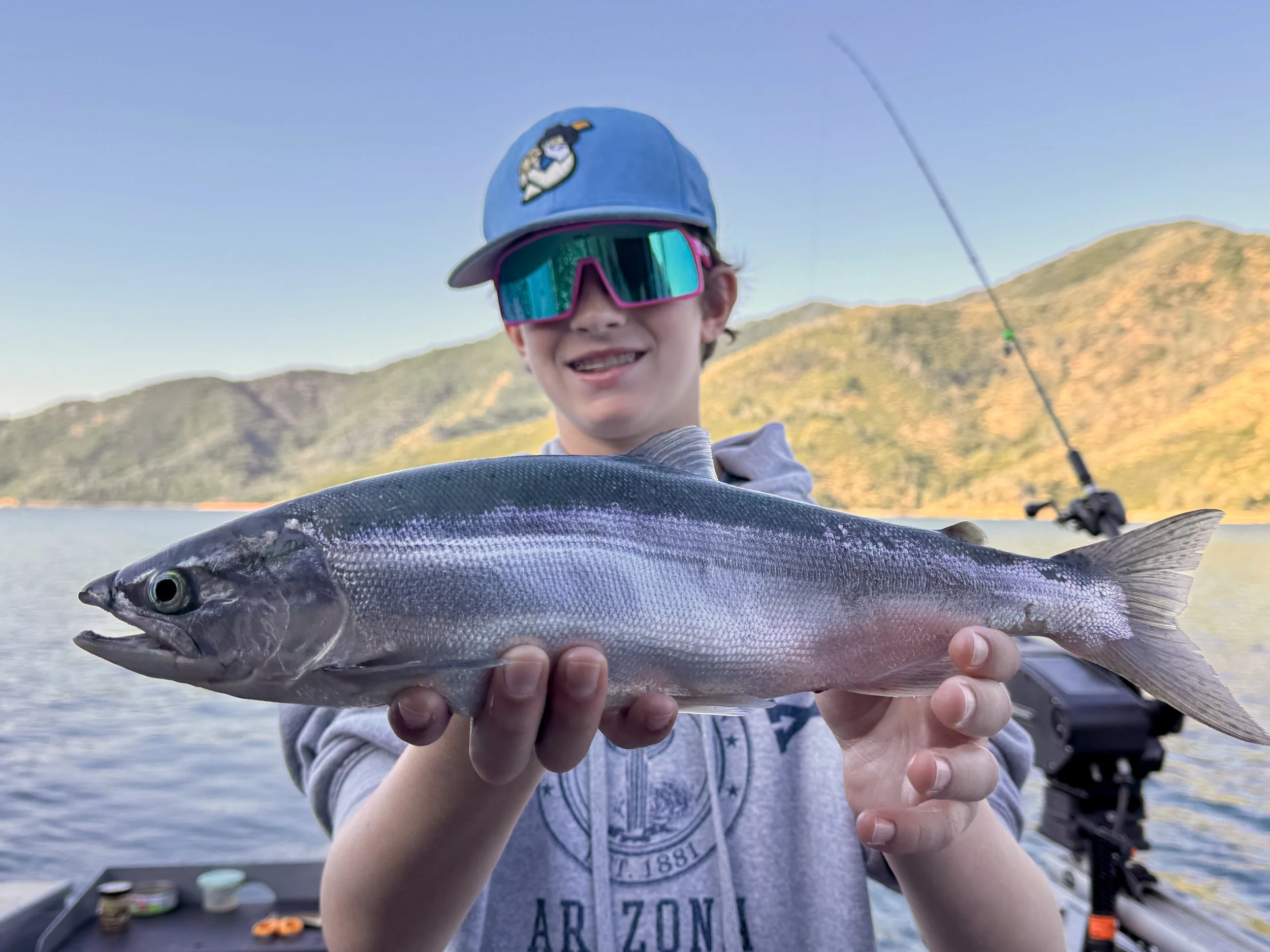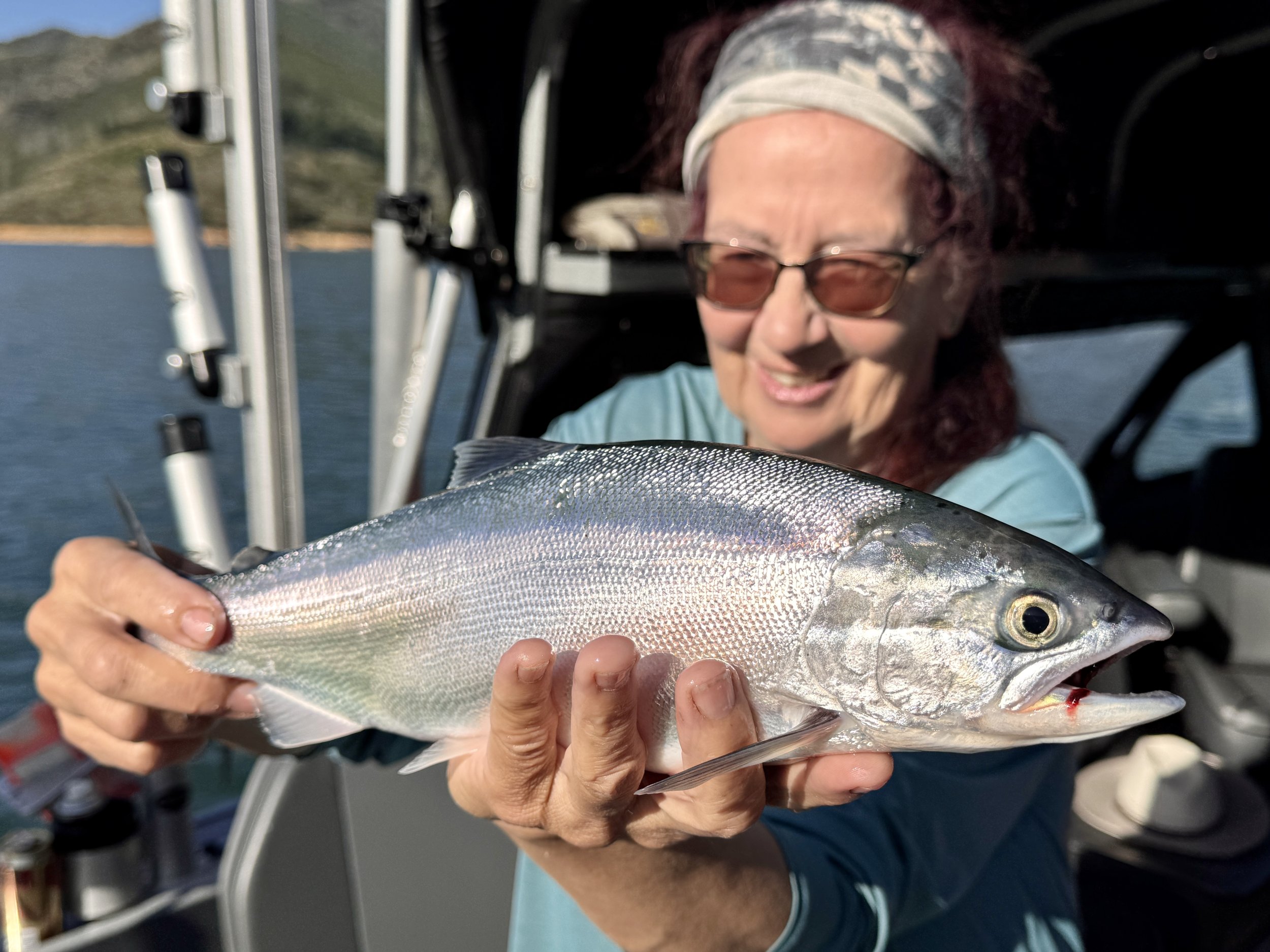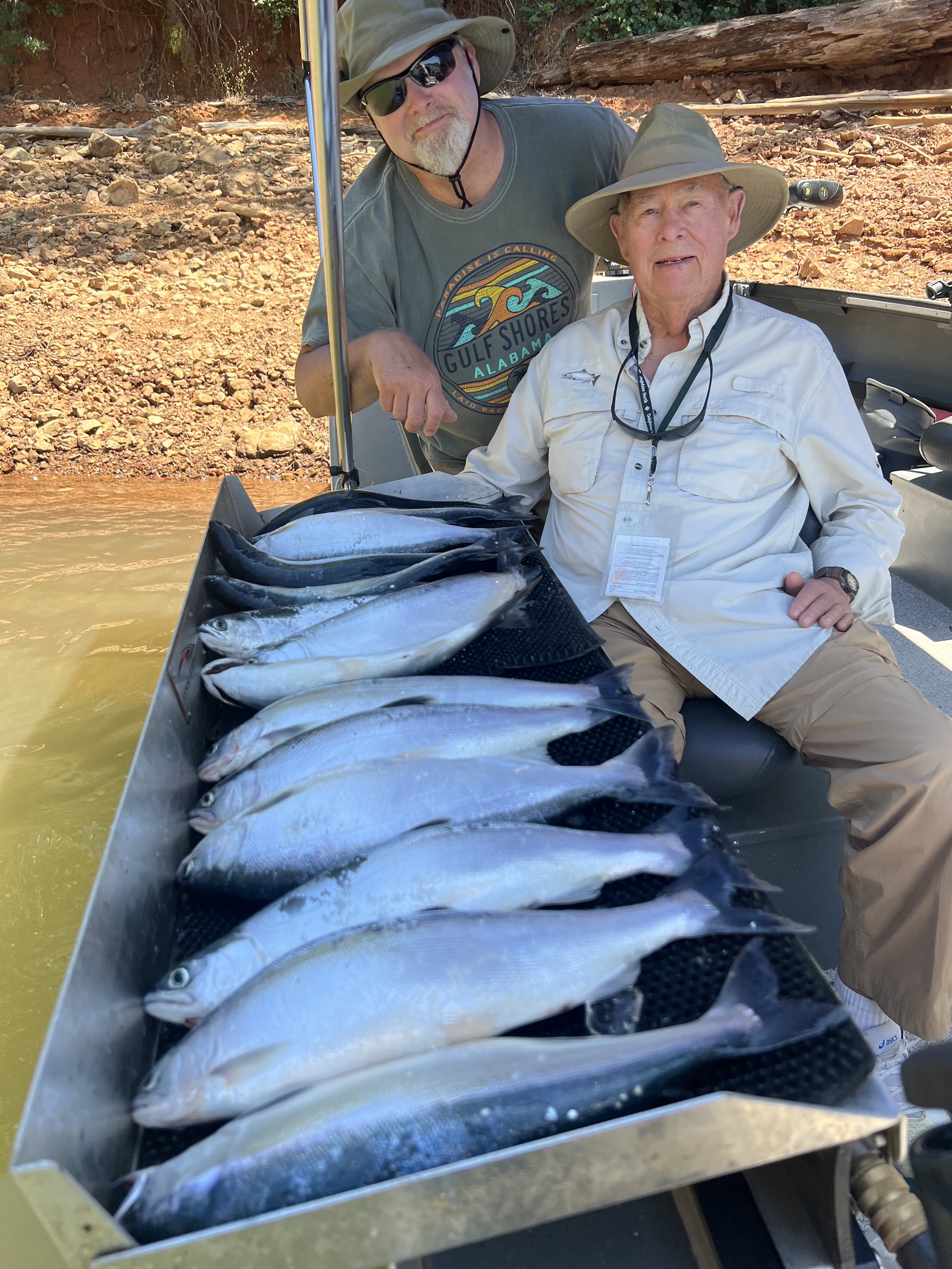2025 Shasta Lake Kokanee salmon.
How to Catch Kokanee Salmon at Shasta Lake: A Complete Guide
Shasta Lake in Northern California is famous for its massive surface area, scenic arms, and outstanding fishing opportunities—including the hard-fighting, delicious Kokanee salmon. Although more commonly associated with aother local lake like Whiskeytown, Shasta has quietly become a sleeper Kokanee fishery. With proper technique, gear, and timing, anglers can put Kokanee in the box and enjoy some of the tastiest salmon around.
In this guide, we’ll cover everything you need to know to catch Kokanee on Shasta Lake—where to find them, what gear to use, and how to troll effectively.
What is a Kokanee Salmon?
Kokanee are landlocked Sockeye salmon. Instead of migrating to the ocean, they live their entire lives in freshwater lakes. Adult Kokanee typically range from 14 to 18 inches long in Shasta, though larger specimens aren’t unheard of. Their firm, pink-orange meat is prized by anglers, and they are a blast to catch on light tackle.
When to Fish for Kokanee at Shasta Lake
The Kokanee season on Shasta generally runs from late spring through early fall. The peak months are May through August, when the water warms and Kokanee begin to school up in the deeper basins of the lake.
Spring (April–May): Fish are higher in the water column, 10–30 feet.
Summer (June–August): They move deeper, typically 40–80 feet or more, depending on water temps and thermocline depth.
Fall (September): Fish start to mature and their quality may drop as they get closer to spawning. Still catchable, but not prime.
Where to Find Kokanee in Shasta Lake
Shasta’s massive size can be overwhelming, but Kokanee tend to concentrate in specific areas:
Top Kokanee Areas:
Waters around the Dam: Deep, cold water attracts summer schools.
Sacramento Arm: Especially near deeper river channels.
Pit Arm: A productive area early in the season.
McCloud Arm: Known for clear water and Kokanee holding near submerged structure.
Dry Creek Inlet & Big Backbone area: Often overlooked but can produce good numbers of Kokanee in the summer months.
Look for schools on your fish finder, particularly near steep underwater points, submerged creek beds, and near the thermocline.
Essential Kokanee Gear
Great Kokanee tackle makes a big difference!
Fishing for Kokanee requires specialized ultralight gear and monofilament lines, as their soft mouths and finicky bites mean you need sensitivity and control.
Rod & Reel
Rod: 7’ to 8’ light-action trolling rod with a soft tip. I use the Kokanee Black series Okuma rods.
Reel: I use the Okuma low profile line counter reels because of the high line capacity and smooth drag.
Line: 8–10 lb fluorocarbon or monofilament mainline. Some anglers use braid with a fluorocarbon leader but we tend to lose more fish with braided lines.
Terminal Tackle
Dodgers/Sling Blades: Small dodgers (4–6”) like the Mack’s Tackle Double D/Sling Blade, Catch America Fishing 6” dodgers, or Brad’s Killer Fishing Gear Dodgers work well. Chrome, pink, orange, or UV finishes are favorites.
Lures: Wedding Rings, hoochies, micro-spinners, and Apex-style lures. Pink, orange, chartreuse, and UV purple are hot colors.
Hooks: Tandem #4 or #2 octopus hooks, snelled for the larger Kokanee at Shasta Lake.
Scents/Corn: Tip your lure with dyed and scented or just white shoepeg corn. Pro-Cure garlic, anise, and krill variety scents are definitely Kokanee killers.
How to Troll for Kokanee
Speed
Troll slow: 1.0 to 1.5 MPH is the Kokanee zone. Any faster and you will see the number of bites you are getting decline.
Depth
Use a downrigger for precise depth control, especially once they’re deep in summer.
In spring, you may flatline or use lead-core line/snap weights, but summer demands downriggers.
Keep track of the thermocline with your Fish Hawk devices and target 5–10 feet below it.
Spread
Run multiple rods if you have a two rod endorsement. Remember, kids under 16 can run two rods without any additional licensing required. More rods in the water means more bites in most cases. Stagger your depths and dodger colors to locate the bite zone.
Dodger Action
Tune your dodger to give a wide, side to side action. Add a slight bend to sling blades if needed.
Use a 8” to 12” leader behind the dodger.
Tips from a Shasta Lake Guide
As a longtime fishing guide on Shasta, here are some real-world tips to up your Kokanee game:
Use a Scent Rotation: Sometimes Kokanee prefer garlic corn in the morning, then krill in the afternoon. Experiment.
Downsize on Tough Days: If the bite’s slow, switch to micro-hoochies or run bare corn on a tiny spinner.
Watch Your Fish Finder: Look for tight schools stacked in a band—often near main lake points or drop-offs.
Change Colors Often: If you’re not getting hit, swap dodger or lure colors every 20 minutes.
Bleed and Ice Them Fast: Kokanee spoil quickly. Bleed them right away and get them on ice for the best meat quality.
Regulations and Limits
Harvest only what you will need!
Always check the latest California Department of Fish and Wildlife regulations before fishing. As of the 2025 season:
Daily Limit: 5 Kokanee per angler (counted separately from trout).
Possession Limit: 10 Kokanee per angler.
Barbless Hooks: Not required, but crushed barbs can help with quick releases.
Final Thoughts
Kokanee fishing at Shasta Lake is both fun and rewarding—and it’s a great way to introduce family or clients to trolling. Once you dial in the depth and color pattern, the action can be fast and furious.
If you’re new to Shasta or want a head start, consider booking a guided Kokanee trip with us. You’ll learn firsthand how and where, dial in your gear, and put fish in the boat.
Tight lines, and we’ll see you out on the water!





